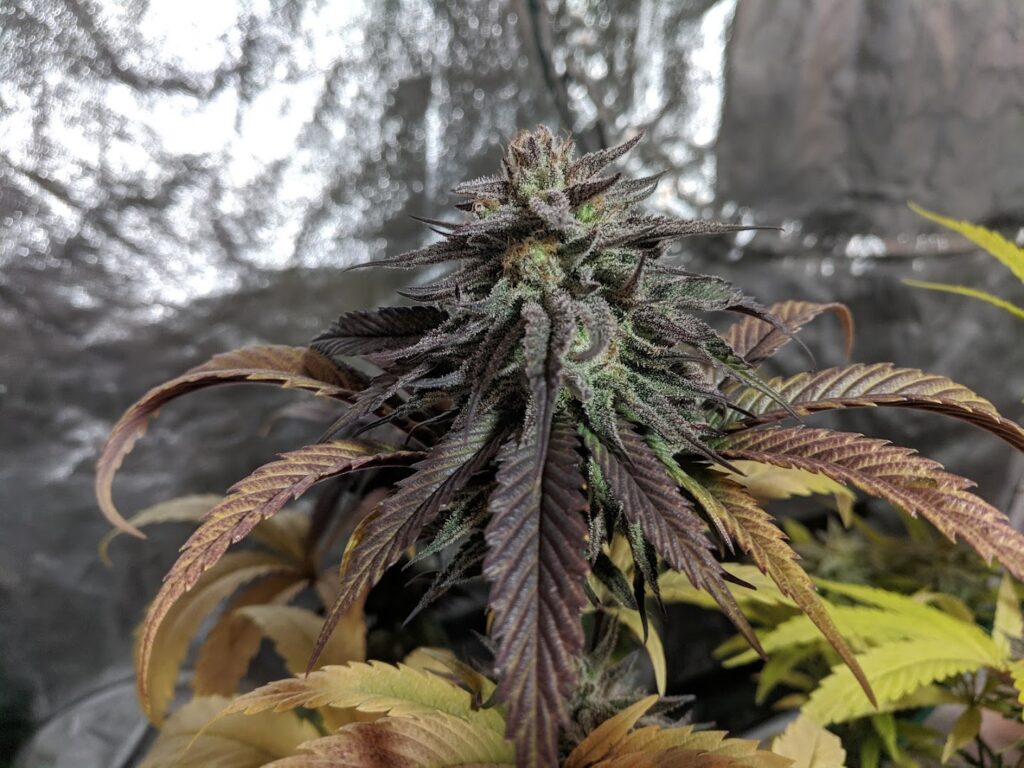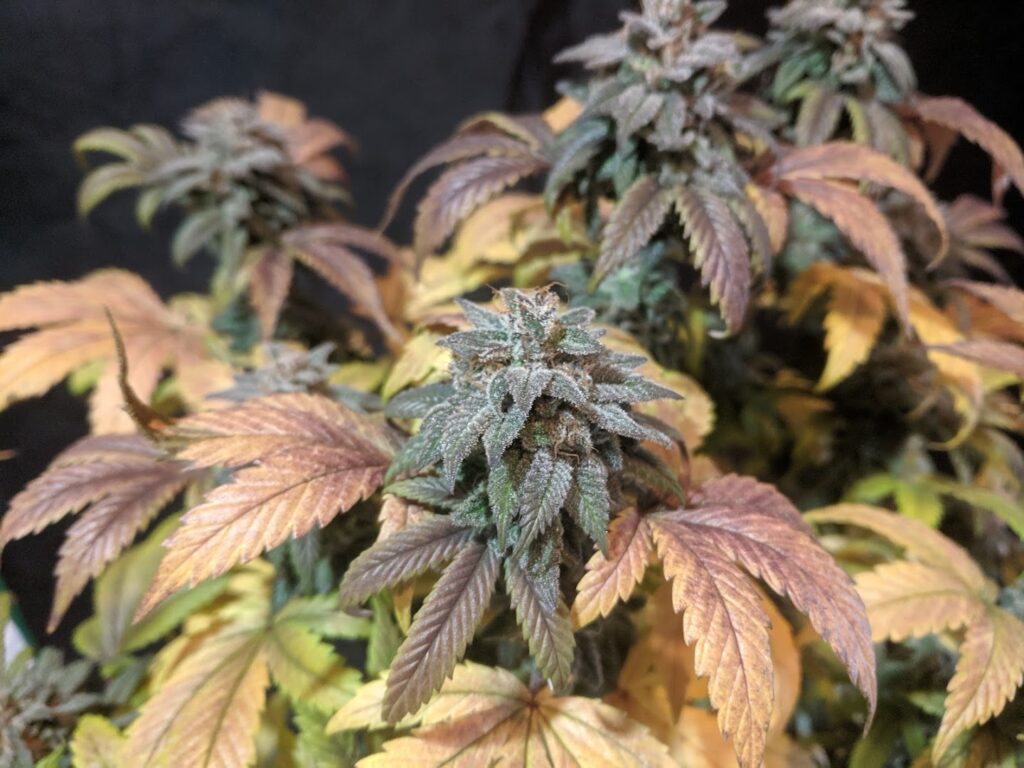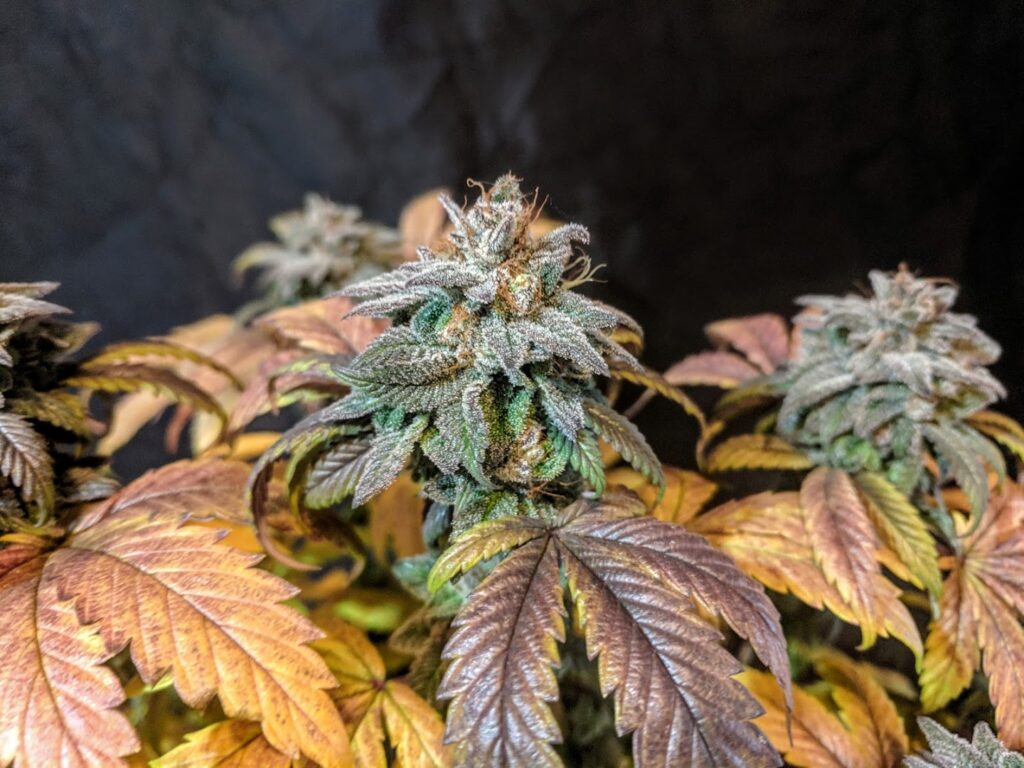Have you ever seen pictures of cannabis plants with beautiful, exotic colors and wondered how they did it? Do you want to grow cannabis flowers that transform from drab greens and browns into bright purples, yellows, oranges, and even reds and blues? This guide will teach you the tricks you need to know to get the most vivid colors in your cannabis garden.
Most often, cannabis coloration is pretty predictable: bright green on new growth, darker green on old growth, and then fading into a dull yellow as the plant flowers. Sometimes though, flowering cannabis plants can put on a spectacular color show in late flowering, displaying a spectrum of colors that can light up your garden. A couple of factors can impact your plants’ coloration and determine whether it will follow the normal progression of green-yellow-brown or take on vivid coloration. We’ll compare cannabis to the fall display of deciduous trees to look at these factors.
Factor 1: Genetics
Coloration is the same for cannabis as it is for trees; the genetics of the specimen will have much to do with the final coloration. Maple trees are a good example; some varieties have red leaves at the end of the season, while others have yellow or orange. With cannabis plants, some strains will be prone to produce bright colors, while others will not.

Factor 2: Environment
Several environmental factors impact how bright or vivid their fall displays with deciduous trees. The amount of water available and what time of the growing seasons (early or late) that drought conditions hit can cause brighter or lighter displays. The temperature throughout the growing season can also impact the autumn display. Temperature, available water, soil acidity, and nutrients all play off one another to determine how bright and vivid the show will be. The same is true of cannabis.
Step 1: Pick the right genetics
There is a surprisingly easy way to find genetics with nice coloration since many strains that produce excellent color shows are named for their coloration. Just search for the color you are looking for, like purple, blue, or orange. Other strains are known to produce good coloration. Here are a few strains we have found to deliver the best color shows:
Purple Fem by Pyramid Seeds is a cross between multiple purple types and produces beautiful purple buds and coloration.
Raspberry Cough by Nirvana Seeds produces beautiful reddish-colored foliage in late-season flowering.
Dark Devil Auto by Sweet Seeds has dark red foliage with a dark purple flower structure. It is a truly striking plant.
Chemical Bride by Greenhouse Seed Co has pinkish-red foliage that stangs in bright display against the powder-white crystals on the bud structure.
There are plenty of other strains that have beautiful coloration. Once you have the best strain, it’s time to set up the best environment for a good color display.

Step 2: Setup the right environment
To optimize the environment to result in the best color display, we need to understand how different environmental factors impact cannabis coloration during late flowering. Cannabis changes colors for the same reasons as deciduous trees change colors in the fall: it is chemical.
What makes cannabis change colors?
Leaves get their colors from pigment molecules. Most leaves have multiple pigments, but the dominant pigment present is chlorophyll, a chemical the plant uses to convert sunlight to energy during the growing season. Chlorophyll reflects green and masks the other pigments. Towards the end of the growing season, the plant will stop producing chlorophyll, and as the pigment molecules break down, the other colors that the chlorophyll masked now become visible.
Deciduous trees go through this process every season as they stop producing chlorophyll for the winter and focus on storing sugars in their root structure for winter. In cannabis, the end of the flowering cycle starts this process when the plant focuses its energy on flower development and reduces chlorophyll production in older leaves. As the green reflecting pigments fade, other pigments become visible. Often, the underlying color transition is to light yellow to brown, but under the right conditions can be spectacular.

What chemicals impact cannabis colors?
Several chemical compounds impact the coloration of cannabis, including
- Chlorophyll: Used for sugar production, pigments produce a bright green color while active and a darker green color as the leaf ages.
- Carotene: Carotenoid terpene that produces yellow and orange colors
- Lycopene: Carotenoid terpene that produces orange and red colors
- Flavanol & Flavone: Flavonoids that produce yellow coloration
- Anthocyanin: Flavonoid that produces red, blue, purple, and magenta colors
The colors your plants present will be mostly dependent on what combinations of these chemicals are present at a given part of its cycle.
How does my plant get the right chemicals?
After chlorophyll production ends, your plant must contain carotene, lycopene, and anthocyanin to produce exotic coloration. You can increase carotene and lycopene availability by adding terpene enhancing supplements to your feeding regimen.
Anthocyanin production requires sugars, so your plant must have access to carbohydrates. Use compost tea as part of your feeding regimen to provide the right balance.
The final step to assuring that your plants have access to the proper chemical compounds is to ensure that the pH is balanced correctly and that you provide it with the right amount of water so that it can carry out the chemical processes it needs to generate anthocyanin.

How does temperature affect coloration?
With trees, cooler temperatures at the end of the season can cause more brilliant displays, which is also true for cannabis. The cold temperatures cause the plant to transition away from chlorophyll production more abruptly as it senses the season’s end. Lowering the temperature to under 60F (~15.5C) at the end of the growing season can improve the color display dramatically.
Conclusion
Cannabis is a beautiful plant, and with just a few steps, you can make its display even more dazzling. Just pick a strain that is known to produce nice colors, increase the terpenes and lower the temperature, and you can grow beautiful cannabis gardens.